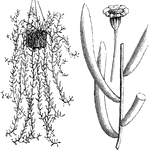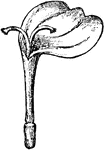Clipart tagged: ‘ragwort’

Othonna Crassifolia
The common name of othonna is ragwort. The crassifolia variety has few flower heads that grow on the…
Disk-floret of the Senecio
An illustration of a disk-floret of the senecio flower. Senecio is a genus of the daisy family (Asteraceae)…

Disk-floret of the Senecio (Longitudinal Section)
An longitudinal section view of a disk-floret of the senecio flower. Senecio is a genus of the daisy…

Female ray-floret of the Senecio
An illustration of a ray-floret of the senecio flower. Senecio is a genus of the daisy family (Asteraceae)…

Gynaeceum of the Senecio
An illustration of the gynaeceum of the senecio flower. Senecio is a genus of the daisy family (Asteraceae)…